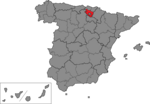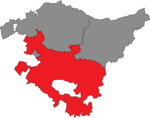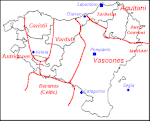Álava

Álava (IPA: [ˈalaβa] in Spanish) or Araba (Basque pronunciation: [aˈɾaba]), officially Araba/Álava, is a province of Spain and a historical territory of the Basque Country, heir of the ancient Lordship of Álava, former medieval Catholic bishopric and now Latin titular see. Its capital city, Vitoria-Gasteiz, is also the seat of the political main institutions of the Basque Autonomous Community. It borders the Basque provinces of Biscay and Gipuzkoa to the north, the community of La Rioja to the south, the province of Burgos (in the community of Castile and León) to the west and the community of Navarre to the east. The Enclave of Treviño, surrounded by Alavese territory, is however part of the province of Burgos, thus belonging to the autonomous community of Castile and León, not Álava. It is the largest of the three provinces in the Basque Autonomous Community in geographical terms, with 3,037 km2, but also the least populated with 331,700 inhabitants (2019).
Excerpt from the Wikipedia article Álava (License: CC BY-SA 3.0, Authors, Images).Álava
Bidegana kalea/Calle Bidegana, Vitoria-Gasteiz
Geographical coordinates (GPS) Address Nearby Places Show on map
Geographical coordinates (GPS)
| Latitude | Longitude |
|---|---|
| N 42.8445 ° | E -2.7603333333333 ° |
Address
Bidegana kalea/Calle Bidegana 3
01015 Vitoria-Gasteiz (Margarita)
Autonomous Community of the Basque Country, Spain
Open on Google Maps






